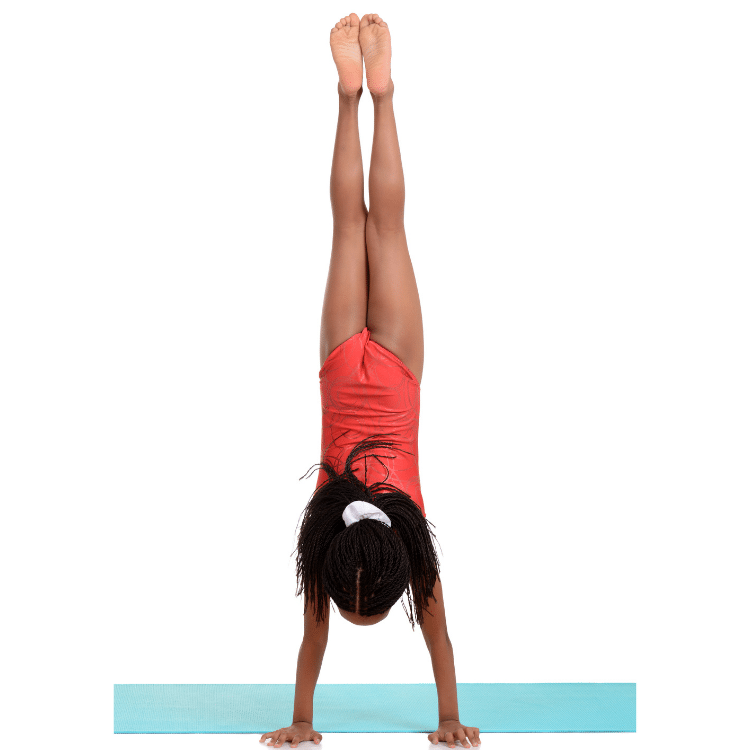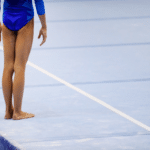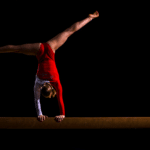Being able to hold a handstand correctly will help a gymnast unlock a world of more advanced skills due the shape being used in so many other movements.
Although a handstand is not particularly difficult in comparison with skills like back handsprings or somersaults, gymnasts have to pay a lot of attention to the technique and body shape used in the handstand.
It’s such an easy move to get wrong so let’s take a closer look at how to hold a handstand.

Table of Contents
Disclaimer: Gymnastics carries an inherent level of risk. Information contained in this article does not replace the need for professional coaching in a recognized gymnastics facility.
How to hold a handstand
Knowing how to hold a handstand is an achievable target for most people. It requires a fair level of strength and body tension but once you have mastered it you will be ready to step up to the next level of gymnastics training.
- Lunge with one foot forward and the arms tight by the ears.
- Reach toward the floor while swinging the back leg up vertically. Keep the back leg straight and pointed.
- Push off the front leg, and have it meet the first leg
- Keep the arms straight, head neutral and torso in a hollow dish
Once you have reached the handstand position, hold it by squeezing and keeping the body tight. Push up (away from the floor) through the shoulders and point the toes and feet.
How to hold a handstand longer
Once you have mastered the handstand you will probably want to hold it for longer. As with every skill in gymnastics you will need to repeat drills over and over again in order to improve.
To hold a handstand for 30 seconds or longer follow the steps below as often as possible.
1. Practice L-handstands (half handstands)
Start on a raised platform around 2 feet in height. Kneel and reach down towards the floor until your arms are straight and your upper body is in the handstand position.
By keeping the knees on the platform it takes a lot of the weight off the hands and you can concentrate on correcting body form and technique.
To extend this drill, have only the feet touching the platform so the legs become fully straightened. You can also lift one leg vertically as if it is in the handstand.
2. Check your shoulder flexibility
Handstands require open shoulders. To check your shoulder flexibility stand with your back facing a wall and lift your arms straight over your head. Your arms should be able to contact the wall comfortably but if your back starts to arch and come away from the wall, it’s a sign your shoulders are struggling to hit the open shape.
Bridges and other shoulder flexibility exercises will help improve shoulder flexibility.
3. Fix your head position
A common mistake in a handstand is to lift the chin and stick the head out. In fact, the head should be in a neutral position so that it is in line with the rest of the body and the ears are in line with the arms and shoulders.
But why is this important? When the head comes out of position other parts of the body often come out of shape to compensate and we usually end up with poor form.
For example, the back will arch like a banana or the legs may bend.
Some people will feel like this helps them hold a handstand for longer and they can be right.
But by cheating with the poor form they will find it hard to perform more advanced skills correctly in the long term. So although poor head position might actually help you hold a handstand for longer it’s really important to fix it if you want to keep learning new stuff.
4. Handstand against the wall (both ways)
A simple way to increase the time you can hold a handstand is by using a wall to help.
But make sure you practice facing both ways – some with your back facing the wall and some with your tummy. Most people find it harder to practice a handstand with their tummy facing but you can start with your hands further away from the wall so you are more diagonal and as you improve, you can walk your hands in towards the wall.

Once you hit the handstand shape focus on improving the body shape and tension – there’s no benefit in holding a poorly shaped handstand for a long time.
5. Roll your hips under
An arched handstand is easy to spot because the back is bendy. But this is also due to the hips not being rolled under. If you can fix this body shape it will help you hold a handstand for longer.
Practice rolling your hips under by laying flat on the floor on your tummy. Stretch your arms forward as if you are in a handstand shape. Try to lift your hips from the floor without lifting any other part of your body.
It’s harder than it sounds – many gymnasts will lift their bum instead and it takes plenty of repetition to start to understand how to isolate and control the hips.
6. Improve your core strength
Lots of people assume you just need lots of strength in your arms to do a handstand but actually core strength will help you hold your handstand for longer.
This is because the ability to stay in balance whilst upside down will mostly come from your core.
Improve your core strength with conditioning exercises like sit-ups, v ups, dish holds, hollow planks and arch holds.
7. Walk on your hands
When a gymnast starts to walk on their hands it raises their awareness of their weight and how to shift it from side to side without losing balance.
It’s worth making time to practice handstand walks even if you can only hold a handstand for a few seconds.
I insist on gymnasts finishing their handstand with good form and control even when they have walked several steps.
Conclusion
Stay focused on the correct body shape even whilst holding a handstand for a longer amount of time. If a gymnast cheats and starts to arch the back, for example, it will negatively impact other gymnastics skills they want to learn. Be prepared to repeat these drills many hundreds of times if you want to see great results.
FAQs
Why can’t I hold a handstand?
If you are struggling to hold a handstand right now, it can be for a variety of reasons.
- Lack of strength
- Poor form
- Poor body tension
- Lack of practice
The good news is that most errors can be corrected and with enough practice, most people will eventually be able to hold a handstand. With enough focus, repitition and hard work, a handstand is achievable for most people.
How long can most people hold a handstand?
Most people who practice handstands regularly should be able to hold a handstand for at least 3 to 5 seconds. By this, I mean free-standing handstands and not using a wall.
Most people who don’t normally practice will find it hard to hold a handstand at all, whereas an elite competitive gymnast should be able to hold a handstand for at least 1 to 2 minutes. An elite gymnast will also be able to hold a variety of handstand shapes, pirouettes, walks and hops.
How do you hold a handstand for 30 seconds?
Follow all of the drills and progressions outlined in this article; L handstands, handstands against a wall and improve shoulder flexibility and core strength in order to achieve the goal of a 30-second handstand.
Why is holding a handstand so hard?
A handstand can be hard because of the small base of support (two hands) which is used to balance the whole weight of the body. Plenty of people have the strength to hold a handstand but lack the technical ability to find their balance and hold the handstand.
Latest Articles
- 19 Fun Trampoline Games for Kids
 Are you looking for fun Trampoline Games to keep your kids entertained? Whether you’re hosting a birthday party, a family gathering, or simply looking for… Read more: 19 Fun Trampoline Games for Kids
Are you looking for fun Trampoline Games to keep your kids entertained? Whether you’re hosting a birthday party, a family gathering, or simply looking for… Read more: 19 Fun Trampoline Games for Kids - Gymnastics Flexibility: The Keys to Success
 Flexibility, sometimes overshadowed by strength and power, is a vital element of gymnastics training. It’s the silent hero that allows gymnasts to glide through air… Read more: Gymnastics Flexibility: The Keys to Success
Flexibility, sometimes overshadowed by strength and power, is a vital element of gymnastics training. It’s the silent hero that allows gymnasts to glide through air… Read more: Gymnastics Flexibility: The Keys to Success - What is a Full-In in Gymnastics?
 One of the most challenging moves in gymnastics is the Full-in. The Full-in is a skill competed on a range of apparatus in Artistic as… Read more: What is a Full-In in Gymnastics?
One of the most challenging moves in gymnastics is the Full-in. The Full-in is a skill competed on a range of apparatus in Artistic as… Read more: What is a Full-In in Gymnastics? - 11 Ways To Use Your Gymnastics Air Track
 Discover 11 amazing things you can do on a gymnastics air track and take your skills to the next level! From perfecting your cartwheel to… Read more: 11 Ways To Use Your Gymnastics Air Track
Discover 11 amazing things you can do on a gymnastics air track and take your skills to the next level! From perfecting your cartwheel to… Read more: 11 Ways To Use Your Gymnastics Air Track - Essential Gymnastics Bar Exercises (for beginners)
 Gymnastics is a sport that requires strength, flexibility, and control, and the bar is one of the most important pieces of equipment used to train… Read more: Essential Gymnastics Bar Exercises (for beginners)
Gymnastics is a sport that requires strength, flexibility, and control, and the bar is one of the most important pieces of equipment used to train… Read more: Essential Gymnastics Bar Exercises (for beginners) - Balance Beam Skills for Beginners
 If you are just starting out in gymnastics you may be wondering what the ideal Balance Beam skills for beginners are. I have put together… Read more: Balance Beam Skills for Beginners
If you are just starting out in gymnastics you may be wondering what the ideal Balance Beam skills for beginners are. I have put together… Read more: Balance Beam Skills for Beginners
